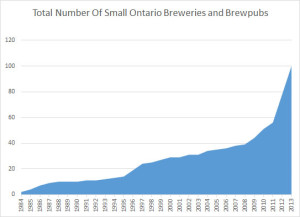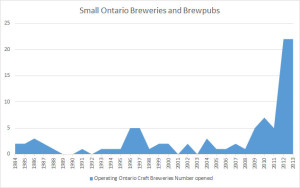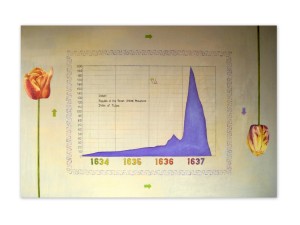The other day, I got a haircut.
This is not news in and of itself, even though I’m relatively pleased with the haircut.
During the smalltalk that goes along with a haircut, I mentioned that I write about beer. It turns out that the stylist had intended at some point last year to open a craft brewery in the city of Toronto. It turns out that he had the funding all ready to go and even had a brewer lined up. There’s always money to open a craft brewery in Toronto, he said. In the states, it’s the only growth industry, he said. The secret is opening with one good brand, he said.
I realize that an anecdote isn’t data, but this is where we are now. There’s money going begging and a guy who cuts hair for a living could open a craft brewery.
Now, as it turns out, the guy was fairly knowledgeable about beer and knew some Toronto contract brewers. I don’t mean to denigrate the guy’s willingness to start a new career but five years ago, this would not have been enough to get investors on board. Venture capitalists would have been leery of entrusting funds to any startup brewery.
Five years ago, the brewing industry landscape in Ontario was a great deal different.
In 2008, there were 38 breweries in Ontario. One off brews were a thing reserved for cask festivals like Cask Days at Bar Volo. Creemore was still independent, Amsterdam was still downtown, IPA was a gleam in the beard of Mike Lackey and nanobrewing sounded like something out of a Michael Crichton novel.
As you can see here, we have actually just this week hit 100 operational breweries and brewpubs. Number 100, near as I can reckon it, was probably Lake Of The Woods in Kenora, Ontario who poured their first beer yesterday. There were three others this week.
For the purposes of full disclosure, I should point out that I have used the Mom and Hops directory and then combed through the websites of these companies in order to find their first year of operation. I have included contract breweries as breweries. Also, the data does not include breweries which fall under the same umbrella. Brick and Waterloo are counted separately as are Creemore, Six Pints and Mad and Noisy.
This is a graph showing the number of Ontario breweries added each year. You’ll notice that last year we had 22 and that we have 22 so far this year with six months to go. There are 25 additional breweries in some form of planning stage that are not yet operational. We might actually double the number of openings this year because I can guarantee that there are breweries slated to open that aren’t on the Mom and Hops radar yet. It’s possible that within two years the number of breweries in Ontario will have doubled.
It’s not just in Ontario, either. The Brewer’s Association claims 2,360 operating members as of March 2013 and 1250 breweries in planning as of April 1, 2013. That means that in 2012 they added about 360 breweries or about a fifth as many as they already had. If you want to see where they’re laid out, the New Yorker has a pretty nifty map.
The growth in the case of Ontario specifically and in North America generally is parabolic in nature and there are some problems with that. I sincerely doubt that there’s a brewery out there whose future business planning is not predicated upon the idea that they will grow and flourish. Confidence is the key to Capitalism, after all. The problems are that customers are a finite resource and the amount of beer consumer is dropping annually in both Canada and the U.S. If you look at the craft beer market segment, it is booming. There’s more reportage on the subject than ever before and experts are getting interviewed left and right.
The thing about parabolic growth is that we’ve seen it as recently as 2007 and it usually doesn’t end well.
I suppose I could use just about any example from Tulips to the South Sea Company to Housing to forex trendy Bitcoin – everybody want to know how to trade bitcoin and
how to do , but it’s probably easiest just to post the explanatory graph.
Coincidentally, I don’t know if you know this, but there’s a movie coming out called Drinking Buddies. It stars Olivia Wilde and Ron Livingston and is set partially in a craft brewery. It is a romantic comedy. If the heavily tattooed brewers that you know seem all PUNK RAWK and a little bit edgy, it’s worth pointing out that a romantic comedy isn’t.
I’m worried, you see, that movies are the death knell for popularity. They get released at the height of a trend. Look at the popularity of break dancing following the release of Breakin’ 2: Electric Boogaloo. Similarly, the popularity of skateboarding (although resurgent in the mid 90’s) took a real hit after being featured in Police Academy 4: Citizens on Patrol. Movies cash in on trends. The cash in part makes me think that we might be hitting the greed portion of the mania phase of the above bubble graph.
When you add to this the fact that the LCBO doesn’t have shelves for all of this stuff and that privatization in Ontario is pretty much a pipe dream for the time being (I still haven’t seen a serious study on that, by the way), it becomes pretty clear that (and I wish I could do a Sean Bean impression here) Winter Is Coming.
So, if you’re an existing brewery, you’re going to want some cash on hand. If you have an onsite store at your brewery, promote the hell out of it. If you’re a start-up brewery and you’re already brewing, for God’s sake do something interesting to differentiate yourself a little (bamboo beer doesn’t seem so silly now, does it?)
And, if you gave me a haircut about a week ago, you might want to wait a couple of years and see how the market shakes out before launching a new brewery in Toronto. Also, thanks for the nifty haircut.

You mention the lack of shelf space at the LCBO, but how many of these new craft breweries are only brewing for draft service? Here in Alberta the choices for craft beer outlets are also growing in leaps and bounds (all things being relative).
That’s a worthwhile question. The answer is “some of them” although I don’t have an exact figure. You’ve got to imagine that even if they have started with only draft, they must be thinking that selling packaged beer should be part of their business plan further down the line. Given the shelving problem, it’ll probably be a single can format if they make it at all. Who knows. The LCBO might shed underperforming brands.
It would be fantastic to walk into a Craft Beer store in Ontario and buy most or if not all of the Craft breweries beers. Too bad this is impossible to most people who live in Ontario. What is our population? Around 13 million? It is a disgrace that you have to live near a Craft brewery to enjoy their beer.
If we’re going to dream, how about dreaming big? Loosen the ties on the distribution channel, and let us have easy access like http://www.cnbc.com/id/46543329/ !
If that happened, there might be people who wouldn’t mind if they wound up working in a gas station.
But, Chris, we need to refer to a map. Ontario is massive. It is unrealistic to expect to find every craft brewery in every store in Ontario. In New York state there are maybe five or six excellent beer stores north of White Plains. Beer stores that have over 1,000 brands. You can’t get all NY state beers in those shops either. Even there with shorter distances and larger buying population, individual production levels and transport costs make reasonably local a matter that defines selection.
There is always room for a fine brewer. Most brewers do not achieve heights of excellence. In earlier years, those with reasonable business savvy could count on doing pretty well, perhaps very well. Today, the stakes are higher. Make a really fine product and people will come (one way or another).
Gary
P.S. Of course, the obverse to the main point above is no less true. But better to reach for the sun even if some wings of wax melt in the process, no beer culture worthy of the name should strive for less IMO.
Based on the amount of growth we are seeing, I wonder how long that the sort of industry camaraderie we have seen in the past will continue. I mean for years small brewers have been promoting each other and trying to give their friends at other breweries more exposure. I mean there was an article a few months ago about how Beau’s basically loaned 2 fermentors and 2 conditioning tanks to Beyond the Pale, essentially for free. When you get to the point where there are 100 breweries, and the number of products is growing faster than people can buy them, competition goes for people’s disposable income increases. With fiercer competition can you afford to promote another company if it means you might lose a customer to them?
Especially when more and more of these new brewers are people like your hair stylist, who are people who want to get into the industry, and have an investor’s money to play with (and then in turn have an investor to answer to with regards to profits). Because I have a feeling those guys probably won’t be promoting or helping their competition.
Hey Jordan,
Are we still having this debate? I’ve been hearing many similar comments, from pundits, brewers, and others, and I just don’t buy it. Craft beer is going to continue to win for a long time. Individual breweries will, sadly fail, as companies fail in any industry, but the scene…the movement…the revolution will thrive for many reasons…
1) There are still a lot of people who don’t drink craft beer: As far as I’m concerned, while the import beer market still has 3 times the craft beer market share and the macro market something like 20 times, there is almost an unending supply of new converts for craft beer.
2) Growth from small breweries: The only death nail craft beer needs to watch out for is commoditization; you know, getting boring. If that happens you will see growth occurring only in the top 5 to 10 brands and new entrants and smaller companies will suffer. In fact, the opposite is the case. People keep pointing to the vast number of new breweries as the reason that the craft beer ‘bubble’ will burst, but they are at the same time pointing to the slowdown in growth of the largest craft brewers as another example. In fact these two things together show the true resilience of the movement – that larger craft brewers are no longer the driving force for growth, but growth is still the same. This means that customers still want MORE choice, that they still want to discover MORE craft beer. This is wonderfully good news to anyone who wants to start a new brewery.
3) 100 breweries in Ontario? That’s nothing! I referred to the map you referenced to compare the number of breweries in Ontario to the US. The map shows hotbed states like Vermont with 20 breweries for every 500,000 people, Oregon with 18.6 and somehow Montana with 18.2. If my math is correct (and I’m not a mathmologist) I see Ontario has 5 breweries for every 500,000 people. Not bad, but certainly not anywhere near what should be seen as a saturation point.
The only thing that I think has changed is some of the optimism within the industry. More established breweries are seeing their own slowdown and blaming the market. Writers are starting to itch for doom and gloom stories because it gets exhausting to keep writing about how wonderful things are, and in general, human nature wants us to fear the future…but the numbers don’t support it, your fancy charts notwithstanding.
Thank you for noticing the fanciness of the charts. I slave away for hours on end to create them down at the chart factory. At night, the chart weasels come.
Can I just point out here how nice it is to have someone arguing the opposing point? I don’t have rebuttals to Steve’s arguments just yet, partially because there hasn’t been enough coffee yet. You can bet I’ll look at them seriously though.
Very well put by Steve Beauchesne, good for you.
Gary
There is still a whole sheesh tonne of room for early adopters and innovative palettes before we see that “peak”. As Steve mentions, the climb is going to be ominous, long and steady for those taking the risks. The educated palettes will prevail and those providing the substance to sustain these interested palettes will continue to drive the movement into an (dare i say it) industry.
Perhaps an intentional analogy. . . ?? . .Doesn’t Sean Bean die in every movie he’s in?..?